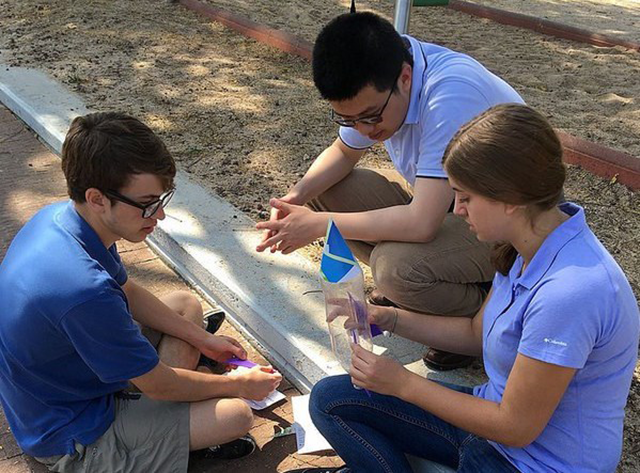
Photo Courtesy of The Gregory School
Editor’s Note: Gregory School junior and Chant reporter Tianyi Zhu is participating in The Gregory School’s physics trip to Israel and sending updates:
March 31, 5:38 PDT
Our whole team is now on the plane to LA, ready to takeoff. We’ll then fly directly from LA to Tel Aviv. The flight is about fourteen hours. Our safe for the competition was disassembled into separate components and put into two carry-on suitcases.
March 31, 12:23 PDT
We are at the LA airport waiting for the flight to Tel Aviv. Our plan is that after we arrive, we will spend about four hours to assemble the safe box from separate pieces and make it fully functional. During the flight, we will be preparing for the presentation of the safe for the competition at the Weizmann Institute.
April 1, 23:29 GMT+3
We walked to the beach near the hotel, enjoyed the coastal view, and looked for local Israeli food. Unfortunately, because of Sabbath, most local restaurants were already closed. We eventually had dinner at an Italian restaurant. During the dinner, we made a plan for the last things to do before the physics competition. After coming back to the hotel, we finished writing the final submission of our design ideas and brain-stormed the possible names for our safe. Before everyone went to bed, we setup the rotors in the second chamber so that we could continue working on it tomorrow.
April 3, 10:28 GMT+3
Yesterday we had a bike trip around the city of Tel Aviv. We visited the square where Israel Prime Minister Rabin was assassinated. In the afternoon we went to the port city of Caesarea. As an important strategic harbor, it had a long history, ruled successively by different peoples in the Middle East. When we came back to the hotel, we continued to work on the safe. Luckily, we managed to solve a series of technical challenges and had the safe fully functional. The whole building process took about six hours. We didn’t go to sleep until after 2 pm (local time). Now I’m on the bus to the Holy city of Jerusalem. We are going to have a tasting tour in the local food market and then head to the Weizmann Institute for the physics competition.
April 4, 22:36 GMT+3
Yesterday when we went through the inspection of the safe, some unanticipated problems occurred – it took too long to activate the mechanism for the second chamber of the safe. After intense discussion and brain-storming, we finally came up with a better solution using backup materials that we brought with us. So we could finally say that the safe is ready for other teams to crack.
Today we had a tour on the campus of the Weizmann Institute. We learned that the Institute is dedicated for research in basic sciences, such as math, physics, chemistry, biology, and computer science. It has a graduate school and offers postgraduate research positions. It was founded by the first president of Israel, Chaim Weizmann, who is also a prominent chemist. He was the leader of the Zionist movement and a great politician. Without him, the establishment of Israel would be impossible. Tomorrow we will have our first day of safe cracking.
April 6, 7:08 GMT+3
Yesterday we had an intense competition day of safe-cracking. All teams were divided into two groups. In the first round, the first group cracked the second group’s safes. In the second round, the second group cracked the first group’s safes. Each team is given 10 minutes for each safe with two 2-minute extensions. Our team did a presentation of our safe to three judges and explained the physics concepts we used to build the safe. After that, we started our safe-cracking tournament.
I am responsible for “guarding” the safe, resetting it each time after a team’s attempt and demonstrating to them the right way to crack it. Other team members went to other safes and tried to win points by successfully unlock the safes of other teams. The competition result is based on how many safes the team crack into, how many times its safe is cracked into, how the judges think about the safes, and peer review.
We cracked 2 out of 6 safes and our safe is cracked into 2 out of 9 times. Some of the safes are very creative, utilizing a variety of scientific principles; other safes are either too convoluted or too tricky to crack. Although we enjoyed the competition, some members pointed out some flaws of the competition, including the lack of well-defined rules. Overall, we had a good time.
Apr. 6, 15:47 GMT+3
Today in the morning we moved our safe from the competition site to the visitor center at the Weizmann Institute to have a public exhibition of our safe along with other teams’ safes. The exhibition not only provided a chance for us to understand how other safes work, but also attracted a huge public crowd who are generally interested in science. We introduced our safe to other team members as well as Israeli teenagers from outside of the Institute.
After seeing a lot of other teams’ safes, the opinion of the team was that our safe was not as impressive as others’ safes in terms of design and functionality. However, in the closing ceremony in the afternoon, the team was thrilled to receive the 4th prize of the competition out of 30 participating teams.
Given that 133 teams from around the world applied and we placed the 4th as a first-year team, the achievement is outstanding. We felt that our six-month hard work finally paid off and the exhausting flights were worthwhile. Although the competition was over, the team would go on to visit the Dead Sea, the Old City of Jerusalem, and other tourist attractions.
